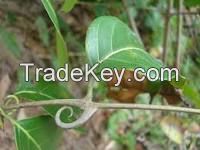タイトルまたは説明
is a large, woody vine
that derives its name from hook-like thorns that grow along the
vine and resemble the claws of a cat. Two closely related species
of Uncaria are used almost interchangeably in the
rainforests: U. tomentosa and U.
guianensis. Both species can reach over *0 m high into the
canopy. U. tomentosa has small, yellowish-white flowers,
whereas U. guianensis has reddish-orange
flowers and thorns that are more curved. Cat's claw is indigenous
to the Amazon rainforest and other tropical areas of South and
Central America, including Peru, Colombia, Ecuador, Guyana,
Trinidad, Venezuela, Suriname, Costa Rica, Guatemala, and
Panama.
There are other species
of plants with a common name of cat's claw (orua de
gato) in Mexico and Latin America; however, they are
entirely different plants, not belonging to
the Uncaria genus, or even the Rubiaceae
family. Several of the Mexican ua de gato varieties have toxic
properties.
TRIBAL AND
HERBAL MEDICINE USES
Both South
American Uncaria species are used by the
indigenous peoples of the Amazon rainforest in very similar ways
and have long histories of use. Cat's claw (U.
tomentosa) has been used medicinally by the Aguaruna,
Ashninka, Cashibo, Conibo, and Shipibo tribes of Peru for at
least 2,**0 years. The Ashninka Indian tribe in central Peru has
the longest recorded history of use of the plant. They are also
the largest commercial source of cat's claw from Peru today. The
Ashninka use cat's claw to treat asthma, inflammations of the
urinary tract, arthritis, rheumatism, and bone pain; to recover
from childbirth; as a kidney cleanser; to cure deep wounds; to
control inflammation and gastric ulcers; and for cancer.
Indigenous tribes in Piura use cat's claw to treat tumors,
inflammations, rheumatism, and gastric ulcers. Other Peruvian
indigenous tribes use cat's claw to treat diabetes, urinary tract
cancer in women, hemorrhages, menstrual irregularity, cirrhosis,
fevers, abscesses, gastritis, rheumatism, tumors, and
inflammations as well as for internal cleansing and to "normalize
the body." Reportedly, cat's claw has also been used as a
contraceptive by several different tribes of Peru (but only in
very large dosages). Dr. Fernando Cabieses, M.D., a noted
authority on Peruvian medicinal plants, explains that the
Ashninka boil 5 to 6 kg (about *2 pounds) of the root in water
until it is reduced to little more than 1 cup. This decoction is
then taken 1 cup daily during the period of menstruation for
three consecutive months; this supposedly causes sterility for
three to four years.
Cat's claw has been
used in Peru and Europe since the early ***0s as an adjunctive
treatment for cancer and AIDS as well as for other diseases that
target the immune system. In herbal medicine today, cat's claw is
employed around the world for many different conditions,
including immune disorders, gastritis, ulcers, cancer, arthritis,
rheumatism, rheumatic disorders, neuralgias, chronic inflammation
of all kinds, and such viral diseases as herpes zoster
(shingles). Dr. Brent Davis, D.C. has written several articles on
cat's claw and refers to it as the "opener of the way" for its
ability to cleanse the entire intestinal tract and its
effectiveness in treating stomach and bowel disorders (such as
Crohn's disease, leaky bowel syndrome, ulcers, gastritis,
diverticulitis, and other inflammatory conditions of the bowel,
stomach, and intestines). Dr. Julian Whitaker, M.D. reports using
cat's claw for its immune-stimulating effects, for cancer, to
help prevent strokes and heart attacks, to reduce blood clots,
and for diverticulitis and irritable bowel
syndrome.
PLANT
CHEMICALS
Cat's claw has several
groups of plant chemicals that account for much of the plant's
actions and uses. First and most studied is a group of oxidole
alkaloids that has been documented with immune-stimulant and
antileukemic properties. Another group of chemicals called
quinovic acid glycosides have documented anti-inflammatory and
antiviral actions. Antioxidant chemicals (tannins, catechins and
procyanidins) as well as plant sterols (beta-sitosterol,
stigmasterol, and campesterol) account for the plant's
anti-inflammatory properties. A class of compounds known as
carboxyl alkyl esters found in cat's claw has been documented
with immunostimulant, anti-inflammatory, anticancerous, and
cell-repairing properties.
Cat's claw contains
ajmalicine, akuammigine, campesterol, catechin, carboxyl alkyl
esters, chlorogenic acid, cinchonain, corynantheine, corynoxeine,
daucosterol, epicatechin, harman, hirsuteine, hirsutine,
iso-pteropodine, loganic acid, lyaloside, mitraphylline,
oleanolic acid, palmitoleic acid, procyanidins, pteropodine,
quinovic acid glycosides, rhynchophylline, rutin, sitosterols,
speciophylline, stigmasterol, strictosidines, uncarine A thru F,
and vaccenic acid.
| 国: |
Peru |
| モデル番号: |
Uncaria tomentosa - Cat's claw
|
| 离岸价格: |
25 ~ 30 / Kilogram ( Negotiable ) (交渉可能)
Get Latest Price
|
| ロケーション: |
Peru |
| 最低注文量の価格: |
25 per Kilogram |
| 最低注文量: |
1 Kilogram |
| パッケージの詳細: |
international packaging |
| 納期: |
30 days |
| 供給能力: |
1000 Kilogram per Year |
| 支払いタイプ: |
Western Union, D/P, D/A, L/C, T/T |
| 製品グループ : |
Herbs
|

